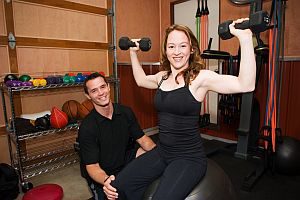The Positive Effects of Chiropractic Care!

We know that our patients who get adjusted regularly see the wonderful side effects! Their backs are not the only beneficiary of their adjustments! Here is a study that confirms that keeping the spine adjusted has more positive effects than just your back or neck feeling better!:
A retrospective study conducted in Sweden [1] has determined that about one in four chiropractic patients experiences some form of “positive nonmusculoskeletal side effect” after spinal manipulative therapy (SMT).
In addition, the percentage of patients who experience positive side effects increases with the number of spinal regions adjusted. The Swedish researchers asked all members of the Swedish Chiropractors Association (SCA) to participate in the study. Eighty-one percent of the SCA membership complied. Each doctor of chiropractic gathered data from 20 patients over a three-week period for a total of 1,504 valid patient questionnaires. Patients were included if they had been previously adjusted within the last two weeks for musculoskeletal complaints. The patients were asked if after their previous visit they ìexperienced any positive changes that do not seem to have anything to do with your back problem?
At least one positive side effect or reaction was reported by 23 percent of the respondents. The more spinal areas that were adjusted, the better their chances of experiencing at least one positive reaction:
The positive, nonmusculoskeletal reactions appear to cluster into a number of system/organ-related classifications. Of those patients who experienced them, here is the breakdown by percentage:
- Respiratory System: 26%
- Digestive System: 25%
- Circulatory System/Heart: 14%
- Eyes/Vision: 14%
The benefits experienced can also be broken down into subcategories:
- Easier to Breathe: 21%
- Improved Digestive Function: 20%
- Clearer/Better/Sharper Vision: 11%
- Better Circulation: 7%
- Changes in Heart Rhythm/Blood Pressure: 5%
- Less Ringing in the Ears/Improved Hearing: 4%
The authors, as is typical in research papers, are careful to point out the limitations of extrapolating the findings. They note that the study does not demonstrate whether the statistical link between treatment and reaction is causal. They assert that ìthe absence of an untreated control group makes it impossible to say whether these reactions are treatment-specific, or if they simply represent normal fluctuations of common symptoms of physiologic function. While these results are very exciting, it is clear that additional research is needed.
Reference:
The Types of Improved Nonmusculoskeletal Symptoms Reported After Chiropractic Spinal Manipulative Therapy
J Manipulative Physiol Ther 1999 (Nov); 22 (9): 559–564
The Abstract
OBJECTIVE: To investigate the frequency and types of improved nonmusculoskeletal symptoms reported after chiropractic spinal manipulative therapy.
DESIGN: Retrospective information obtained by chiropractors through standardized interview of patients on return visit within 2 weeks of previous treatment.
SETTING: The private practice of 87 Swedish chiropractors (response rate 81%).
SUBJECTS: Twenty consecutive (presumably naive) patients per chiropractor (1504 valid questionnaires returned, 86% of optimal number of replies).
INTERVENTION: Spinal manipulation with or without additional therapy provided by chiropractors.
MAIN OUTCOME MEASURES: Self-reported improved nonmusculoskeletal symptoms (reactions).
RESULTS: At least I reaction was reported after the previous treatment in 21% to 25% of cases. Of these responses, 26% were related to the airway passages (usually reported as “easier to breathe”), 25% were related to the digestive system (mostly reported as “improved function”), 14% were classified under eyes/vision (usually reported as “improved vision”), and 14% under heart/ circulation (about half of these reported as “improved circulation”). The number of spinal areas treated was positively associated with the number of reactions.
CONCLUSION: A minority of chiropractic patients report having positive nonmusculoskeletal reactions after spinal manipulative therapy but such reports cluster predominantly around specific symptoms. It would be interesting to find out if these can be verified objectively and, if so, to investigate if they are caused by the treatment or if they are signs of natural variations in human physiology.


 The Mayo Clinic describes second impact syndrome (SIS) as a complication arising from a concussion. It occurs when someone experiences a second concussion prior to fully recovering from the initial one. With SIS, “typically fatal brain swelling” occurs. R.C. Schneider first described this condition in 1973, but it wasn’t until 1984 that someone gave it the name, “second impact syndrome”. The condition is rare enough that only 21 cases had been cited in the literature up until 2003.
The Mayo Clinic describes second impact syndrome (SIS) as a complication arising from a concussion. It occurs when someone experiences a second concussion prior to fully recovering from the initial one. With SIS, “typically fatal brain swelling” occurs. R.C. Schneider first described this condition in 1973, but it wasn’t until 1984 that someone gave it the name, “second impact syndrome”. The condition is rare enough that only 21 cases had been cited in the literature up until 2003.
 Why “low impact” cardio exercises? Imagine reaching your “golden years” with a buff beach body only to be told that you can’t jog or run anymore because your knee cartilage has been worn thin or you have damaged vertebrae. The last thing you want to do is ruin your body while trying to stay in shape. Here we present some good low impact cardio exercises that can help you maintain a healthy cardiovascular system without causing damage to your musculoskeletal system.
Why “low impact” cardio exercises? Imagine reaching your “golden years” with a buff beach body only to be told that you can’t jog or run anymore because your knee cartilage has been worn thin or you have damaged vertebrae. The last thing you want to do is ruin your body while trying to stay in shape. Here we present some good low impact cardio exercises that can help you maintain a healthy cardiovascular system without causing damage to your musculoskeletal system. In life, it’s nearly always possible to have too much of a good thing, and moderation is usually the right common-sense prescription (no matter what the advertisers say). Screen time is no exception. But how much is too much? That’s the question many parents are asking…
In life, it’s nearly always possible to have too much of a good thing, and moderation is usually the right common-sense prescription (no matter what the advertisers say). Screen time is no exception. But how much is too much? That’s the question many parents are asking…
 Forming new habits can be just as difficult as breaking old ones. But when you stop to think about it for a moment, it is clear that all of our habits, both positive and negative, had a beginning—a time BEFORE the behavior became a clear, recognizable pattern. In other words, there was a time when your current habits weren’t yet habits at all!
Forming new habits can be just as difficult as breaking old ones. But when you stop to think about it for a moment, it is clear that all of our habits, both positive and negative, had a beginning—a time BEFORE the behavior became a clear, recognizable pattern. In other words, there was a time when your current habits weren’t yet habits at all! Manual therapies have been used to treat musculoskeletal disorders for thousands of years. Practitioners around the world—in countries with many different cultural influences and diverse medical traditions—have used their hands to manipulate various parts of the body to stimulate healing. “Manual” literally means “by hand.” Thus, manual therapies consist of healing techniques that use the hands. There are more than two dozen techniques used worldwide. Among the most commonly known are acupressure, chiropractic, massage therapy, physiotherapy, reflexology, Rolfing and shiatsu.
Manual therapies have been used to treat musculoskeletal disorders for thousands of years. Practitioners around the world—in countries with many different cultural influences and diverse medical traditions—have used their hands to manipulate various parts of the body to stimulate healing. “Manual” literally means “by hand.” Thus, manual therapies consist of healing techniques that use the hands. There are more than two dozen techniques used worldwide. Among the most commonly known are acupressure, chiropractic, massage therapy, physiotherapy, reflexology, Rolfing and shiatsu.